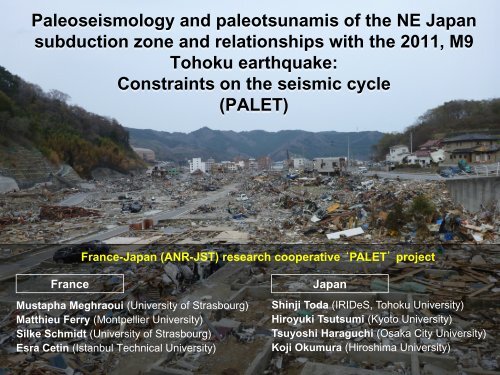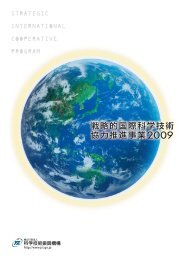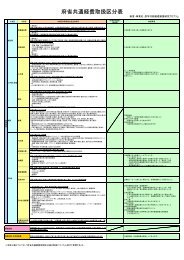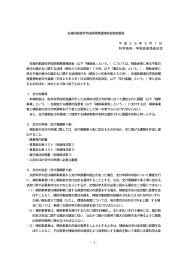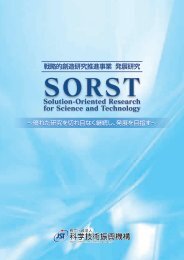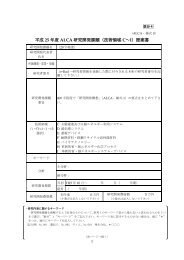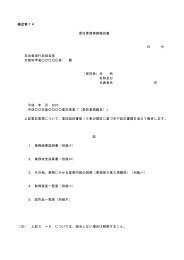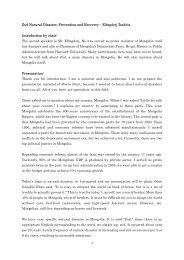Paleoseismology and paleotsunamis of the NE Japan subduction ...
Paleoseismology and paleotsunamis of the NE Japan subduction ...
Paleoseismology and paleotsunamis of the NE Japan subduction ...
You also want an ePaper? Increase the reach of your titles
YUMPU automatically turns print PDFs into web optimized ePapers that Google loves.
<strong>Paleoseismology</strong> <strong>and</strong> <strong>paleotsunamis</strong> <strong>of</strong> <strong>the</strong> <strong>NE</strong> <strong>Japan</strong><br />
<strong>subduction</strong> zone <strong>and</strong> relationships with <strong>the</strong> 2011, M9<br />
Tohoku earthquake:<br />
Constraints on <strong>the</strong> seismic cycle<br />
(PALET)<br />
France-<strong>Japan</strong> (ANR-JST) research cooperative ‘PALET’ project<br />
France<br />
Mustapha Meghraoui (University <strong>of</strong> Strasbourg)<br />
Matthieu Ferry (Montpellier University)<br />
Silke Schmidt (University <strong>of</strong> Strasbourg)<br />
Esra Cetin (Istanbul Technical University)<br />
<strong>Japan</strong><br />
Shinji Toda (IRIDeS, Tohoku University)<br />
Hiroyuki Tsutsumi (Kyoto University)<br />
Tsuyoshi Haraguchi (Osaka City University)<br />
Koji Okumura (Hiroshima University)
2011 Tohoku rupture may be a “super cycle” earthquake<br />
Super Cycle<br />
Simons et al.,<br />
2011<br />
Normal Cycle
To reveal <strong>the</strong> seismic cycle <strong>of</strong> M9 events<br />
1. Paleo-tsunami record in Holocene deposits<br />
2. Long-term behavior <strong>of</strong> directly triggered<br />
inl<strong>and</strong> normal faults<br />
• Long-term deformation using marine terraces<br />
<strong>and</strong> comparison with <strong>the</strong> 2011 coseismic<br />
movements
Back marsh inundated by <strong>the</strong> 2011 tsunami may preserve older events<br />
「 東 日 本 大 震 災 大 船 渡 市 ・ 陸 前 高 田 市 記 録 写 真 集 気 仙 の 惨 状 」 村<br />
田 プリントサービス(2011)による
Back marsh inundated by <strong>the</strong> 2011 tsunami may preserve older events<br />
MHG-02<br />
MHG-01<br />
TYA-01<br />
TYA-02<br />
200 m
Back marsh inundated by <strong>the</strong><br />
2011 tsunami may preserve<br />
older events
800-m-apart two cores share <strong>the</strong> same Tsunami<br />
event horizons in Rikuzen-Takata<br />
Event MH2<br />
5 cm
800-m-apart two cores share <strong>the</strong> same Tsunami<br />
event horizons in Rikuzen-Takata<br />
Event TY2<br />
5 cm
Offshore tsunami deposits from Otsuchi reveal major tsunamis,<br />
possibly every hundreds <strong>of</strong> years, ra<strong>the</strong>r than every 1,000 yr<br />
AD1960 Chili Tsunami<br />
Haraguchi et al. (2006), Haraguchi & Ishibe (2009),<br />
Haraguchi et al. (2012, AGU poster)
Offshore tsunami deposits from Otsuchi reveal major tsunamis,<br />
possibly every hundreds <strong>of</strong> years, ra<strong>the</strong>r than every 1,000 yr<br />
Tr: inter-event<br />
time<br />
AD1960 Chili Tsunami<br />
Haraguchi et al. (2006), Haraguchi & Ishibe (2009),<br />
Haraguchi et al. (2012, AGU poster)
Onshore evidence for paleo-tsunamis along Sanriku coast<br />
suggests about 500-yr recurrence <strong>of</strong> huge tsunamis<br />
Sendai<br />
Haraguchi et al. (2006), Haraguchi & Ishibe (2009), Haraguchi et al. (2012, AGU poster)
Toge<strong>the</strong>r with <strong>the</strong><br />
Sendai <strong>and</strong> Fukushima<br />
data, large tsunamis<br />
might have occurred<br />
every 350-550 years<br />
Sawai et al. (2007)
Ano<strong>the</strong>r way to infer seismic cycle <strong>of</strong><br />
M~9 megathrusts is from paleoseismic<br />
data on triggered coastal normal faults<br />
2011<br />
source<br />
(Simons, et<br />
al., 2011)
Ano<strong>the</strong>r way to infer seismic cycle <strong>of</strong><br />
M~9 megathrusts is from paleoseismic<br />
data on triggered coastal normal faults<br />
M≥4<br />
6 mo.<br />
Toda et al.,<br />
2011
April 11, 2012 earthquake (Mw 6.6): Normal faulting surface rupture
April 11, 2012 earthquake (Mw 6.6): Normal faulting surface rupture
Trenches across <strong>the</strong> Itozawa fault exposed evidence for <strong>the</strong> past events<br />
Tsunagi
Trench walls at Tsunagi, nor<strong>the</strong>rn Itozawa fault<br />
W<br />
E<br />
10<br />
2011 displacement<br />
20<br />
30<br />
40<br />
North wall<br />
2011<br />
displacement<br />
50<br />
32,190-31,650 cal y.B.P.<br />
30,640-30,370 cal y.B.P.<br />
60<br />
10<br />
20<br />
30<br />
40<br />
South wall<br />
Flipped<br />
50<br />
60<br />
1 m<br />
1 m
Trench walls at Tsunagi, nor<strong>the</strong>rn Itozawa fault<br />
W<br />
E<br />
10<br />
2011 displacement<br />
20<br />
30<br />
40<br />
North wall<br />
2011<br />
displacement<br />
50<br />
32,190-31,650 cal y.B.P.<br />
30,640-30,370 cal y.B.P.<br />
60
Our trench wall exposed evidence for <strong>the</strong> penultimate surface rupturing shock<br />
East<br />
1.1 m (2011 event)<br />
West<br />
Liquefaction<br />
Fault<br />
MRE: 12,600〜17,400 cal.yBP
A group <strong>of</strong> normal faults<br />
in Fukushima could<br />
reveal M9 super cycles<br />
M9<br />
TIME<br />
869?<br />
2011
Contradiction between 2011 coseismic subsidence <strong>and</strong> long-term coastal uplift<br />
Coseismic<br />
vertical<br />
movement<br />
Aomori<br />
MIS 5e (120-130 ka)<br />
Koike & Machida, 2001<br />
Iwate<br />
40 m<br />
MIS 19 (783ka)<br />
MIS 17 (688ka)<br />
MIS 15 (572ka)<br />
MIS 13 (482ka)<br />
MIS 11 (406ka)<br />
MIS 9 (328ka)<br />
MIS 7 (214ka)<br />
MIS 5e (125ka)<br />
Miyagi<br />
Fukushima<br />
30<br />
40<br />
50<br />
60<br />
70 m<br />
50<br />
40<br />
Koike & Machida, 2001<br />
Ozawa et al., 2011
Older marine terraces (680-850 ka) are<br />
at altitudes <strong>of</strong> 150-250 m on <strong>the</strong> nor<strong>the</strong>rn<br />
Sanriku coast: Longterm uplift
Wave-cut notches<br />
Miyako
Centennial geodetic data shows<br />
continuous (interseismic?)<br />
subsidence<br />
Nishimura (2012)
Kesen<br />
-numa<br />
To explain <strong>the</strong> Sanriku coastal data, ei<strong>the</strong>r:<br />
1) Gradual but episodic uplift occurs between earthquakes<br />
2) 2011 M9 event typical, with long-term subsidence<br />
3) A hidden huge event is still needed to uplift <strong>the</strong> coast
Major Outcomes<br />
• 350-550 years <strong>of</strong> recurrence interval <strong>of</strong> extreme large tsunamis<br />
hit <strong>the</strong> Sanriku coast<br />
• Presumed active faults in Fukushima Hamadori region, triggered<br />
by <strong>the</strong> 2011 earthquake, are confirmed active <strong>and</strong> recurrence<br />
interval <strong>of</strong> surface rupturing earthquakes on each fault is in <strong>the</strong><br />
order <strong>of</strong> 10,000 years.<br />
• Marine terraces along <strong>the</strong> Tohoku pacific coast have been<br />
uplifted at 0.2-0.4 mm/yr <strong>and</strong> 0.1-0.2 mm/yr in Aomori-nor<strong>the</strong>rn<br />
Iwate, <strong>and</strong> Iwate-Fukushima respectively during late Quaternary<br />
period. The latter region corresponds to <strong>the</strong> 2011 earthquake.<br />
• Toge<strong>the</strong>r with <strong>the</strong>se findings, we model crustal deformation <strong>and</strong><br />
estimate <strong>the</strong> maximum 550-year recurrence intervals <strong>of</strong> M9 class<br />
earthquakes.


